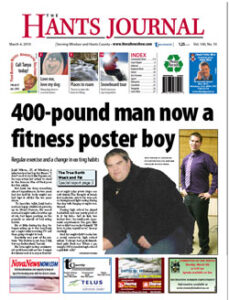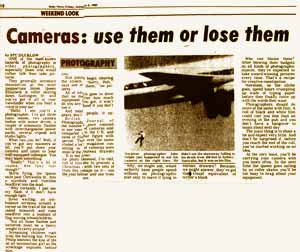Signs of tension but cultures co-exist.
Daily News
Sept. 30 1975
Officially, at least, there are no “hippies” living in the Slocan Valley.
Such terms ruffle the feathers of people working for the department of human resources, the RCMP or the human rights commission.
When pressed, however, members of the above government agencies make vague references to “members of the counter culture”. And that culture is extremely varied, they hasten to add.
Nevertheless, there is a conflict between two troups of people in the Slocan Valley, according to provincial Labour Minister Bill King, who called it “a very unhealthy situation” at a news conference last week.
Most people here call it a “a tempest in a teapot.”
Mr. King also referred to a “near-riot” in Slocan Village where people were beaten and kicked allegedly because some of them were on welfare.
But Cpl. Wayne McLaren, of the RCMP’s Crescent Valley detachment has another view of that incident, which happened Aug. 4.
“It was an incident that quite frequently happens in a bar on a Saturday night anywhere,” he said in a telephone interview.
Two people were charged with a total of four counts of common assault and one charge of assault causing bodily harm after a fight broke out at 6:30 p.m. in the Slocan Inn, Aug. 4, he said.
Cpl. McLaren added there are a lot of transient youth in the valley in the summertime, “and that’s subject to controversy,” but he knows of no organized campaign against them.
Social worker David Maxwell, who lives and works in Crescent Valley, said there are definite signs of tension between groups but the situation’s getting better.
“It’s a free-floating kind of prejudice” against people trying to live alternative lifestyles, he said, but it’s not based on any hard information.
The biggest cause of bad feelings between groups is the fear of some parents that their children will be introduced to drugs.
The second biggest cause of hostility, he says, is swearing, especialy if the taboo is broken by women.
Mr. Maxwll divides Slocan Valley residents into three groups that, he says, identify each other pretty well: Doukhobors, Anglos and freaks.”
The last group is composed of two factions: those who are chronic losers and those who seem to have a clearly defined dirction. “There’s a difference,” he says. “They may both be on welfare, but there’s a difference in approach. If there were jobs, they’d be out doing them. The other people are loafers, just along for the ride. They’ll drift on when they get bored, just like they’ve gotten bored with everything else.”
About one-third of the freaks in the valley are the losers, Mr. Maxwell estimates, and they’re giving the others a bad name.
Most of them are street freaks who move out to the country becuse that’s the thing to do, he says. Many of them use marijuana, but there are few dealers among them, and they don’t sell to local people, he says.
“It’s not fair to lump them all together,” said Mr. Maxwell. “There’s good and bad in every group.
“Some people are very definitely making it out here.” There are several organized societies working for changes in the valley, a lot of craftspeople doing woodwork, weaving, potery, stained glass making and even making wood stoves. Several farms are now almost self sufficient, he says. Some residents go to Vancouver in the winter to make money to improve their land.
The tension between groups is most evident in the children, says Mr. Maxwell. He says three of his clients had their cars vandalized by juveniles in the area.
Charges that most longhairs are on welfare are unfounded says Bill English, of the department of human resources.
“Most people, it doens’t matter whether they have long hair or short hair, really want to be self-sufficient,” Mr. English said. “They just do it different ways.” Though the deparment doesn’t have information on the nature of welfare recipients, Mr English said there are no more people on welfare in the Slocan Valley than anywhere else and there’s not a disproportionate number of young people on welfare in the Valley compared to other areas, he sid.
“The far greater majority of Slocan people are self sufficient,” said Mr. English, and those who are on welfare have a legitimate excuse.
“The labour picture is getting worse, rentals near town are hard to get and expensive. I don’t think a lot of people on welfare just sit around and do nothing,” he said.
Nelson is a pretty tolerant town, he said, but only up to a certain point. In the summertime when the transient population incrases and a lot of young people go barefoot in the city, “there’s a lot of mumbling.”
Ken Hughes who has covered incidents of discrimination under the human rights commission for the past two years said there is more discrimination against longhairs in Nelson than there is in the Slocan Valley.
‘It’s an archaic kind of thinking among “squares” — if that’s an appropriate term— that fails to recognize the rights of other people to do their own thing,” he said.
Most complaints from Slocan Valley residents that are documented in writing come from a pretty hard-core group, he said. He’s only had a couple dozen” such doumented cases in the last two years.
“Not a day goes by without phone calls,” he said, usually dealing with longhairs who have been refused serivce in pubs. Most discrimination problems are fixed up informally on the phone. About 95 per cent of such complaints are quickly solved, he said.
“The Slocan Valley is not a nest of trouble any more than any other area,” he said. There’s a fine group of people in the Valley, but neither side is lily white. I wish they would come together and talk it out.”
Most people who come to the human rights commission complaining of discrimination, do so because of the deparment’s word of mouth reputation, he said, but there are a lot more discrimination problems than the department knows about.
Pat Roberts, a probation officer who covers most of the Slocan Valley, said the so-called hippie element contributes little to criminal activity in the Valley.
“They’re expected to have drugs,” said Ms. Rogers, but that’s the extent of their criminal activity. As far as violent crimes, “not by hipies.”
Most breaking and entering and mischeif incidents are caused by children from better homes in the area, she said.
Within the Valley, hippies are accepted, she said. But on the fringes, where they’re not so easily accepted, the trouble starts.
She said there is more tenion at Mt. Sentinel School near Crescent Valley on the edge of the Valley than there is at W.E. Graham Secondary School in Slocan, inside the Valley.
Though many of these people need social assitance to get started in the Valley, they’re definitely not all welfare bums, said M. Rogers.
More longhairs in the Valley seem to know what they want and they’re doing it,” she said.
“In Nelson, it’s the in thing to grow long hair, but they don’t know what they want to do.”
Most people seem to disagree that the tension reported in the valley is the inevitable result of a large influx of people in recent years.
“People need scapegoats,” said Bill English. “Right now, it’s hipppies and draft dodgers.”
Ken Hughes agrees: there’s a certain kind of militancy that looks and finds thiings that aren’t there on both sides.”
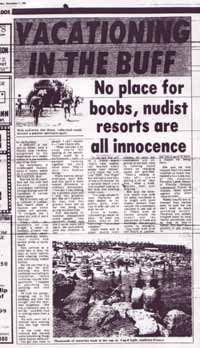 Nudist camps no place for boobs
Nudist camps no place for boobs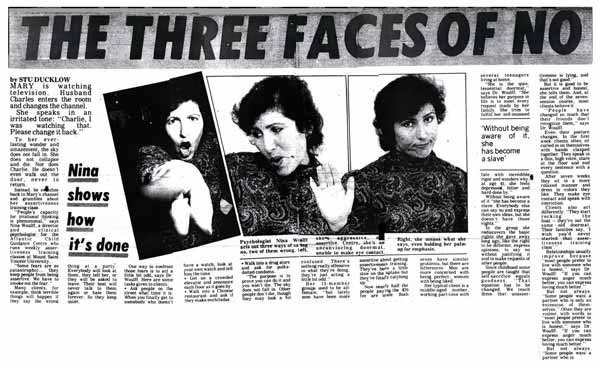
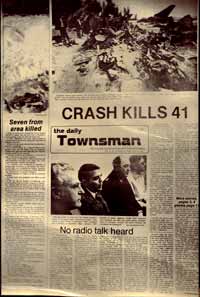 I’ll never fly again
I’ll never fly again